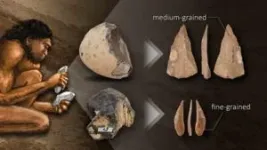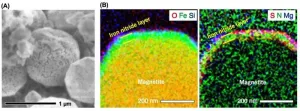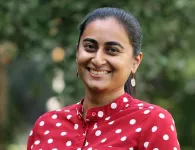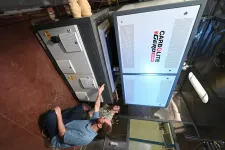(Press-News.org) Researchers at the University of Sydney Nano Institute have invented a compact silicon semiconductor chip that integrates electronics with photonic, or light, components. The new technology significantly expands radio-frequency (RF) bandwidth and the ability to accurately control information flowing through the unit.
Expanded bandwidth means more information can flow through the chip and the inclusion of photonics allows for advanced filter controls, creating a versatile new semiconductor device.
Researchers expect the chip will have application in advanced radar, satellite systems, wireless networks and the roll-out of 6G and 7G telecommunications and also open the door to advanced sovereign manufacturing. It could also assist in the creation of high-tech value-add factories at places like Western Sydney’s Aerotropolis precinct.
The chip is built using an emerging technology in silicon photonics that allows integration of diverse systems on semiconductors less than 5 millimetres wide. Pro-Vice-Chancellor (Research) Professor Ben Eggleton, who guides the research team, likened it to fitting together Lego building blocks, where new materials are integrated through advanced packaging of components, using electronic ‘chiplets’.
The research for this invention has been published in Nature Communications.
Dr Alvaro Casas Bedoya, Associate Director for Photonic Integration in the School of Physics, who led the chip design, said the unique method of heterogenous materials integration has been 10 years in the making.
“The combined use of overseas semiconductor foundries to make the basic chip wafer with local research infrastructure and manufacturing has been vital in developing this photonic integrated circuit,” he said.
“This architecture means Australia could develop its own sovereign chip manufacturing without exclusively relying on international foundries for the value-add process.”
Professor Eggleton highlighted the fact that most of the items on the Federal Government’s List of Critical Technologies in the National Interest depend upon semiconductors.
He said the invention means the work at Sydney Nano fits well with initiatives like the Semiconductor Sector Service Bureau (S3B), sponsored by the NSW Government, which aims to develop the local semiconductor ecosystem.
Dr Nadia Court, Director of S3B, said, “This work aligns with our mission to drive advancements in semiconductor technology, holding great promise for the future of semiconductor innovation in Australia. The result reinforces local strength in research and design at a pivotal time of increased global focus and investment in the sector."
Designed in collaboration with scientists at the Australian National University, the integrated circuit was built at the Core Research Facility cleanroom at the University of Sydney Nanoscience Hub, a purpose-built $150 million building with advanced lithography and deposition facilities.
The photonic circuit in the chip means a device with an impressive 15 gigahertz bandwidth of tunable frequencies with spectral resolution down to just 37 megahertz, which is less than a quarter of one percent of the total bandwidth.
Professor Eggleton said: "Led by our impressive PhD student Matthew Garrett, this invention is a significant advance for microwave photonics and integrated photonics research.
“Microwave photonic filters play a crucial role in modern communication and radar applications, offering the flexibility to precisely filter different frequencies, reducing electromagnetic interference and enhancing signal quality.
“Our innovative approach of integrating advanced functionalities into semiconductor chips, particularly the heterogenous integration of chalcogenide glass with silicon, holds the potential to reshape the local semiconductor landscape."
Co-author and Senior Research Fellow Dr Moritz Merklein said: “This work paves the way for a new generation of compact, high-resolution RF photonic filters with wideband frequency tunability, particularly beneficial in air and spaceborne RF communication payloads, opening possibilities for enhanced communications and sensing capabilities."
DOWNLOAD photos and copy of research at this link.
MEDIA ENQURIES
Marcus Strom | Science Media Adviser | The University of Sydney
+61 474 269 459 | marcus.strom@sydney.edu.au
RESEARCH
‘Integrated microwave photonic notch filter using a heterogeneously integrated Brillouin and active-silicon photonic circuit’ (Nature Communications, November 2023)
DOI: 10.1038/s41467-023-43404-x
DECLARATION
The authors have no competing interests. Research was funded in part by the Australian Research Council. Professor Ben Eggleton is Co-Director of the New South Wales Smart Sensing Network.
END
Photonic chip that ‘fits together like Lego’ opens door to semiconductor industry
Integrating photons into electronic chips expands bandwidth and filter control
2023-12-01
ELSE PRESS RELEASES FROM THIS DATE:
Meteorites likely source of nitrogen for early Earth
2023-12-01
Micrometeorites originating from icy celestial bodies in the outer Solar System may be responsible for transporting nitrogen to the near-Earth region in the early days of our solar system. That discovery was published today in Nature Astronomy by an international team of researchers, including University of Hawai'i at Mānoa scientists, led by Kyoto University.
Nitrogen compounds, such as ammonium salts, are abundant in material born in regions far from the sun, but evidence of their transport to Earth's orbital region had been poorly understood.
"Our recent findings suggests the possibility that a greater amount of nitrogen compounds than previously ...
Can artificial intelligence improve life science? As much as life science can improve AI, researchers say
2023-12-01
Artificial intelligence (AI) may attempt to mimic the human brain, but it has yet to fully grasp the complexity of what it means to be human. While it may not truly understand feelings or original creativity, it can help us better understand ourselves — especially our physical bodies in health and in disease, according to a series of articles recently published by the journal Quantitative Biology.
The peer-reviewed papers — a variety of editorials, perspectives and commentaries on AI for life science — assess the rapid development of AI and recent attention ...
CureSHANK seeking RFAs to stimulate research of SHANK3-related epilepsy in Phelan-McDermid syndrome
2023-12-01
CureSHANK will award a total of $250,000 aimed at stimulating research on SHANK3-related epilepsy, prevalent in PMS patients. The grants, CureSHANK Research to Cure Grant: Epilepsy (R2C Epilepsy), will provide targeted funding to support SHANK3-related epilepsy research projects. The awards aim to improve mechanistic and clinical knowledge of SHANK3-related epilepsy.
The PMS community lives under the long shadow of epilepsy: it is responsible for many deaths of both children and young adults with PMS, and it is among the disorder's most distressing symptoms. Nearly one-third of individuals living with PMS are diagnosed with epilepsy, often evolving ...
Eating beans improves gut health, regulates immune and inflammatory processes in colorectal cancer survivors
2023-12-01
HOUSTON ― Incorporating navy beans into the diet of colorectal cancer (CRC) survivors has the potential to positively impact both gut and host health by modulating markers linked to obesity and disease, according to new research from The University of Texas MD Anderson Cancer Center.
The findings published today in eBIOMedicine, part of The Lancet family of journals, revealed BE GONE trial participants who added a cup of navy beans daily to their regular meals saw positive changes in their gut microbiome, which is associated with cancer prevention and improved treatment outcomes. Changes included an increase ...
One of the largest magnetic storms in history quantified: Aurorae covered much of the night sky from the Tropics to the Polar Regions
2023-12-01
In early November of this year, aurora borealis were observed at surprisingly low latitudes, as far south as Italy and Texas. Such phenomena indicate the impacts of a solar coronal mass ejection on the Earth's magnetic field and atmosphere. Far more dramatic than this recent light show was, it was nothing compared to a huge solar storm in February 872. The resulting auroral display from that event ringed the globe and produced auroras observed in sites as close to the equator as Bombay and Khartoum. An international team consisting of scientists from nine counties has now published a detailed study of this historically important event, tracing its ...
Consensus needed on when global warming reaches 1.5°C
2023-12-01
Writing in the journal Nature ahead of COP28, a team of Met Office scientists has emphasised that – surprisingly – there is currently no formally agreed way of defining the current level of global warming relevant to the Paris Agreement.
They have proposed a solution.
While the global average temperature in a particular year is well-known, this will not be suitable as an indicator of whether the “Paris 1.5” has been breached or not, because the Paris Agreement refers to long-term warming, not individual years.
But no alternative has yet been formally agreed.
Without ...
Study identifies barriers that limit young men at HIV risk from taking preventative drug
2023-12-01
Results of a qualitative research study into the uptake of PrEP - a drug which stops HIV infecting the body - suggests that more needs to be done to breakdown barriers to access for the potentially lifesaving medication.
Research published in the Journal of Prevention and Health Promotion from a team at the University of Bath finds that knowledge and awareness among young men who have sex with other men about the drug is low and there is often stigma associated with being prescribed PrEP.
Pre-exposure prophylaxis ‘PrEP’ refers to a pill that prevents HIV contraction in HIV-negative individuals. PrEP ...
New project investigating how aerosols could affect climate change in near future
2023-12-01
A researcher from The University of Texas at Austin has received a grant from the National Oceanic and Atmospheric Administration (NOAA) to study how changing aerosol pollution could influence climate change in the United States in the coming decades.
Aerosols are tiny solid particles and liquid droplets that contribute to smog and are emitted from industrial factories, power plants and vehicle tailpipes, as well as natural sources like volcanic eruptions. These small particles can influence the Earth’s climate by reflecting or absorbing sunlight and changing the behavior of clouds.
Geeta ...
Physicians, scientists agree increased East-West travel has negative impacts on student-athletes through sleep and circadian disruption
2023-12-01
Announcements in June 2022 of possible realignments of major east-west athletic conferences raised concern among many sleep and circadian physicians and scientists across the United States. As a result of such changes, student-athletes would suffer the negative consequences of increased travel—especially with travel that that crosses time zones and induces jet lag.
Because of the concern over the demise of the Pac12, leading to more east-west trips, a group of sleep and circadian scientists and physicians have published a white paper ...
Arizona State, Idaho National Laboratory team to boost clean energy research
2023-12-01
Idaho National Laboratory (INL) and Arizona State University (ASU) have agreed to expand their joint efforts in clean energy research for the next five years. An agreement signed in October establishes a framework for both institutions to develop low-carbon processes for the energy and manufacturing sectors.
One joint project works to improve and decarbonize methods to extract critical minerals needed for renewable energy generation, energy storage and high-tech electronics. Another effort will develop solutions to electrify process heating, a major pathway to decarbonizing heavy manufacturing.
Researchers from INL and ASU have previously ...
LAST 30 PRESS RELEASES:
New study overturns long-held model of how plants coordinate immune responses.
New AI model predicts disease risk while you sleep
Scientists discover molecular ‘reshuffle’ and crack an 80-year-old conundrum
How stressors during pregnancy impact the developing fetal brain
Electrons lag behind the nucleus
From fungi to brain cells: one scientist's winding path reveals how epigenomics shapes neural destiny
Schizophrenia and osteoporosis share 195 genetic loci, highlighting unexpected biological bridges between brain and bone
Schizophrenia-linked genetic variant renders key brain receptor completely unresponsive to both natural and therapeutic compounds
Innovative review reveals overlooked complexity in cellular energy sensor's dual roles in Alzheimer's disease
Autism research reframed: Why heterogeneity is the data, not the noise
Brazil's genetic treasure trove: supercentenarians reveal secrets of extreme human longevity
The (metabolic) cost of life
CFRI special issue call for papers: New Frontiers in Sustainable Finance
HKU Engineering scholar demonstrates the smallest all-printed infrared photodetectors to date
Precision empowerment for brain "eavesdropping": CAS team develops triple-electrode integrated functional electrode for simultaneous monitoring of neural signals and chemical transmitters during sleep
Single-capillary endothelial dysfunction resolved by optoacoustic mesoscopy
HKU three research projects named among ‘Top 10 Innovation & Technology News in Hong Kong 2025’ showcasing excellence in research and technology transfer
NLRSeek: A reannotation-based pipeline for mining missing NLR genes in sequenced genomes
A strand and whole genome duplication–aware collinear gene identification tool
Light storage in light cages: A revolutionary approach to on-chip quantum memories
Point spread function decoupling in computational fluorescence microscopy
BacPhase: Long-insert paired-end sequencing for bin marker construction and genome phasing
GmWOX1 regulates the mediolateral polarity of compound leaves in soybean
ChargeFabrica: An open-source simulation tool that aims to accelerate search for high performance perovskite solar cells
High levels of ADAR overexpression induce abundant and stochastic off-target RNA editing in rice protoplasts
On-demand upgraded recycling of polyethylene and construction of sustainable multifunctional materials based on the "LEGO" strategy
New "Stomata in-sight" system allows scientists to watch plants breathe in real-time
Anorexia nervosa may result in long-term skeletal muscle impairment
Narrative-based performance reviews deemed fairest by employees
New insights reveal how advanced oxidation can tackle emerging water pollutants
[Press-News.org] Photonic chip that ‘fits together like Lego’ opens door to semiconductor industryIntegrating photons into electronic chips expands bandwidth and filter control







